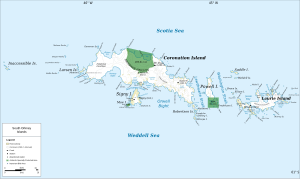South Orkney Islands
| South Orkney Islands | ||
|---|---|---|
| Panorama on Signy Island with the Signy station | ||
| Waters | Southern ocean | |
| Geographical location | 60 ° 41 ′ S , 45 ° 11 ′ W | |
|
|
||
| Main island | Coronation Island | |
| Total land area | 622 km² | |
| Residents | 17 (winter crew 2010) | |
| Map of the South Orkney Islands | ||
The South Orkney Islands are a group of islands north of the Antarctic Peninsula on Drake Strait . Under international law, they fall under the Antarctic Treaty , which does not allow any state sovereignty in the Antarctic , but are claimed by Great Britain and Argentina .
history
The South Orkney Islands were discovered in 1821 by whalers George Powell (1794-1824) and Nathaniel Palmer . In 1823 they were given their current name by James Weddell . In 1903 the islands were visited by the Scottish National Antarctic Expedition led by William Speirs Bruce , who wintered on Laurie Island . Bruce set up a weather station on Orcadas , which he ceded to the Argentine Meteorological Service on his return to Buenos Aires and which still exists today.
The archipelago is just within the territory that is subject to the Antarctic Treaty . The distance to the Antarctic peninsula is approx. 600 km. The area is 622 km², with Coronation Island in the west being the largest. The island of Laurie is much better known because of the Orcadas research station . In between there are numerous other islands and archipelagos , such as Signy Island or Powell Island .
climate
The southern Orkney Islands are the sun- poorest area on earth with an annual average of only 478 hours of sunshine . The weather, dominated by westerly winds , is mostly cloudy and foggy.
The archipelago is under the changing influences from the north and south, which means that in summer and autumn there is an oceanic influence, the temperature fluctuations are only slight. In winter and spring, it is the continental influence that causes large temperature fluctuations.
The warmest month is February with +1.3 ° C, the coldest month with −8.5 ° C July. The lowest temperature so far was measured on August 3, 1904 at −40.1 ° C, the warmest at 14.3 ° C. In November there is usually more than 60 cm of snow at the research station, but it will melt away by March. The sea is covered with ice from June to November.
| Orcadas del Sur, South Orkney Islands | ||||||||||||||||||||||||||||||||||||||||||||||||
|---|---|---|---|---|---|---|---|---|---|---|---|---|---|---|---|---|---|---|---|---|---|---|---|---|---|---|---|---|---|---|---|---|---|---|---|---|---|---|---|---|---|---|---|---|---|---|---|---|
| Climate diagram | ||||||||||||||||||||||||||||||||||||||||||||||||
| ||||||||||||||||||||||||||||||||||||||||||||||||
|
Average monthly temperatures and rainfall for Orcadas del Sur, South Orkney Islands
Source: wetterkontor.de
|
|||||||||||||||||||||||||||||||||||||||||||||||||||||||||||||||||||||||||||||||||||||||||||||||||||||||||||||||||||||||||||||||||||||||||||||||||||||||||||||||||||||
Vegetation and fauna
The southern Orkney Islands are an Antarctic desert, the few ice-free spots mainly contain mosses and lichens , as well as two types of flowering plants, the Antarctic Schmiele and the Antarctic Perlwort .
There are some bird - and penguin species represented, usually the Weddell Seal , sometimes leopard seals , Ross seals or Crabeater Seal .
In 2008, 23 scientists from five different institutes examined the islands over a period of more than seven weeks. Surprisingly, they found more than 1200 species - including sea urchins , worms, crabs and mollusks. According to the scientists involved, these islands are home to more animal species than the Galápagos Islands .
References and comments
- ^ John Stewart: Antarctica - An Encyclopedia . Vol. 2, McFarland & Co., Jefferson and London 2011, ISBN 978-0-7864-3590-6 , p. 1244
- ^ Dull Island . In: Süddeutsche Zeitung of October 30, 2017, p. 18.
- ↑ Antarctica: Scientists catalog life in the ice desert. In: Spiegel Online . December 1, 2008, accessed December 16, 2012 .


